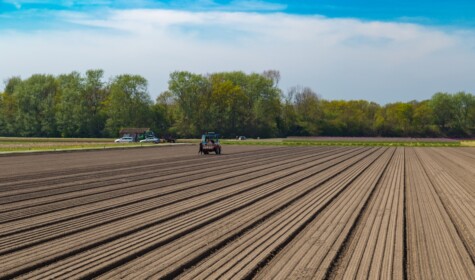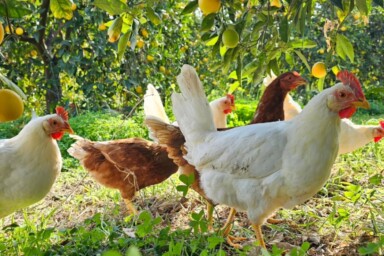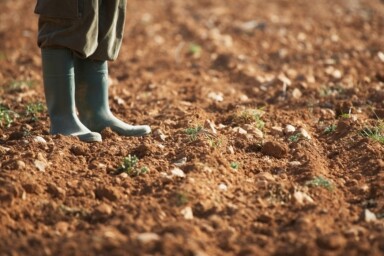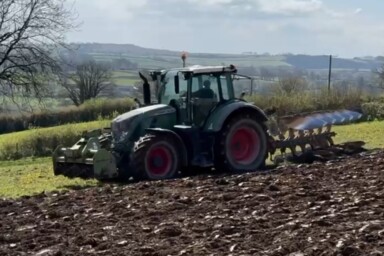Soil is vital to all life on earth. As the American farmer and poet Wendell Berry once said, “Soil is the great connector of lives, the source and destination of all. It is the healer and restorer and resurrector, by which disease passes into health, age into youth, death into life. Without proper care for it we can have no community, because without proper care for it we can have no life.”
Yet this essential foundation of our culture, our agriculture and our food system is losing its heart – its organic matter – and with this, its stability, resilience and productivity. Globally, more than half of all soils are now classified as degraded, with approximately 1.5 billion people living on degraded land. This damage, largely the result of industrial farming practices, over-grazing and global warming, generates an enormous hidden cost to society.
When snow covered the UK earlier this year, the loss of topsoil became starkly apparent as the white snow was rapidly covered with brown earth from eroded fields.
As our report on The Hidden Cost of UK Food shows, the loss of soil carbon across the UK costs us £3.21 billion annually and an estimated $6.3 to $10.6 trillion at a global level.
Soil is an essential resource and the source of over 99% of all human and animal food calories. It can be created from by the weathering of parent rocks, as it was initially, but it can take 500-1,000 years to produce a single inch of soil this way and it will take much longer still, before repeated cycles of plant growth and decay make the soil fully fertile.
Soil contains 25% of global biodiversity and supports an intricate ecosystem of microorganisms, invertebrates, insects and small mammals.
Yet industrial farming has been a mining operation, plundering organic matter, damaging soil structure and destroying soil biodiversity. Soil scientists have variously claimed that the UK has only enough soil left for another 100 harvests, while globally soils are only capable of producing another 60 harvests, something still relevant to the UK given the extent to which we rely on imported food.
This doesn’t necessarily mean that all soils will be completely exhausted within that time, but that at the current rate, the productivity of many soils will have declined so much that farmers will be unable to produce enough food for the global population, regardless of how much fertiliser they apply or the type of seeds they sow.
Carbon accounts for about half of all organic matter, nitrogen for much of the rest. The conversion of grassland to cropland inevitably results in a significant loss of organic matter, with carbon and nitrogen from the soil transferred to the atmosphere in the form of the greenhouse gases, carbon dioxide and nitrous oxide. Although clay soils are more resilient than lighter soils to the loss of organic matter, where the land is used for growing crops year after year and not periodically returned to grass, organic matter losses also result in loss of soil structure. This makes the soil more vulnerable to erosion, which becomes a particular problem if cropland is left bare over winter. Some 3 million tonnes of topsoil are lost in the UK each year. Globally, 24 billion tonnes are lost annually, 3.4 tonnes for every adult and child on the planet.
When snowy weather hit the UK earlier this year, the problem became starkly apparent as photos of ‘snoil’ (snow-covered soil) began appearing on social media. George Monbiot, who is rightly concerned about soil degradation – yet fails to understand the importance of grass and grazing animals in restoring degraded soils – used the images to highlight the problem of arable fields losing their topsoil. Soon people were tweeting photos from around the UK.
There is, of course, an economic cost to all this damage.
Aside from undermining food security and jeopardising biodiversity, a new report has warned that globally more than 3.2 billion people are already affected by soil degradation, and this is driving migration and conflict.
Furthermore, soil degradation increases the chance of flooding, as soils that have lost organic matter cannot absorb and retain substantial amounts of water. In addition, 2,000 hectares of productive farmland has been lost every day on average over the last 20 years, due to salinisation mostly caused by the overuse of irrigation in very hot regions. This has an estimated annual economic cost of $27.3 billion. But the annual cost of soil degradation overall has been estimated at between $6.3 trillion and $10.6 trillion. And because degraded soils cannot retain moisture to the same degree as soils rich in organic matter, they are also vulnerable to droughts. With major droughts seen in recent years from California to Argentina to Cape Town, and even the UK periodically, this is something which urgently needs addressing before food shortages and environmental damage become endemic.
Soil stores 2,500 billion metric tonnes of carbon, almost twice as much as in the atmosphere and over four times the 560 billion tonnes found in plants and animals. So, our top priority has to be to stop further soil degradation and keep all that carbon in the soil. But most cropland has already lost between 40-60% of its organic carbon to the atmosphere. To reverse this, real systemic change is required in the way land is managed. A return to mixed farming – integrating crop production with grassland and grazing livestock, along with deeper rooting plants and returning organic waste to farmland ideally through compost – is essential to rebuild soil fertility and organic carbon levels. For every 1% increase in soil organic matter, the first foot of soil is able to hold an additional 16,500 gallons of water per acre.
Currently, such practices are not rewarded and there is little economic incentive for farmers to farm in this way. Fortunately, however, this issue is being taken more seriously by the government. Michael Gove MP, the Secretary of State for the Environment, has spoken about the need to restore soil health and said it will be one of the ‘public goods’ farmers must look after and provide as part of the new subsidy system. The agricultural bill due to be published later this year will contain a section devoted to soil health, according to Rebecca Pow MP, Parliamentary Private Secretary to environment ministers. She indicated that there would be a target to reverse the decline in soil fertility and restore health by 2030.
So, there is cause for hope, but this issue must be at the forefront of both the public and policymakers’ minds when considering the sort of agriculture we want to see in the future. Improving soil health is a win-win strategy with potential to bring environmental and net economic benefits, as well as securing one of the most vital resources on the planet for future generations. But the benefits to many farmers in the short term don’t always cover the extra costs involved. However, they also benefit society as a whole, and this provides the social justification for the financial support of farmers who adopt practices which both protect and enhance soil carbon levels – public money for a very clear public good.







